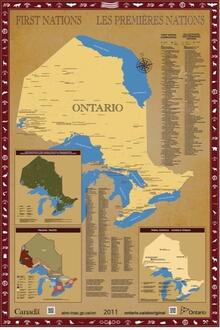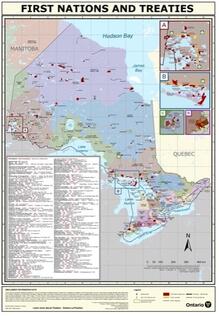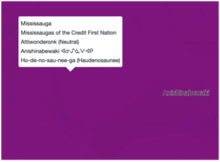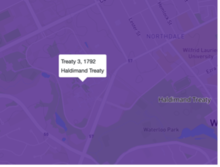University of Waterloo Library's Student Engagement Committee is thrilled to deliver our first Indigenous Heritage Month newsletter! Tell all your friends so they can subscribe to our library newsletters, and keep an eye our for our Pride newsletter coming later this month!
Learn more about Indigenous History Month from University of Waterloo's Human Rights, Equity and Inclusion.
This map provides a geographic representation of First Nation communities, tribal councils, reserves, political organizations, and land covered by specific treaties in Ontario. The map visualizes the many cultural affiliations within numbered communities that receive funding from Indian and Northern Affairs Canada. Looking closer at the smaller maps, each of them provide more spatial information on the treaties, First Nation political organizations, and tribal councils. This First Nations map does not include other Indigenous communities such as Inuit and Metis peoples, therefore it is important to consider the inaccuracies and omissions that may exist within the boundaries of this map.
This Treaties map illustrates the 46 treaties within Ontario. Treaties are legally binding agreements between the federal and provincial governments and the First Nations. They were signed between 1781 to 1930, starting out as negotiations between the British Crown and the First Nations. However, it is essential to note that many treaties were not fulfilled due to exploitation of Indigenous peoples by colonial plans. Treaties are an important step towards reconciliation, however there needs to be action in accordance with the Truth and Reconciliation Commission's calls to action to ensure current treaties are fulfilled and other steps towards reconciliation and justice actions are taken.
Check out this interactive map featuring Indigenous territories, treaties, and languages. Use this resource to find out what traditional territories and treaties you are situated on where you live and work. The images above show the land where the University of Waterloo is situated. It is important to be aware of the territories and treaties where you live, work, and spend recreational time.
To further your learning about which territories we are currently residing on and whom they were promised to, please see the land acknowledgement information below.
The University of Waterloo acknowledges that its Waterloo, Kitchener and Cambridge campuses are situated on the Haldimand Tract, which is land that was granted to the Haudenosaunee of the Six Nations of the Grand River. This land is within the territory of the Neutral, Anishinaabe and Haudenosaunee people.
The University of Waterloo also acknowledges that its Stratford campus is on the territory of the Anishinaabe, Haudenosaunee and Ojibway/Chippewa people. This land is covered by the Upper Canada Treaties.
By publicly acknowledging the land the University of Waterloo is situated on, we bring light to the history of this land and it is a small step forward in repairing the nation's relationship with the original inhabitants of our region.

Map source: Adam Lewis, "Living on Stolen Land," Alternatives Journal December 2015
These Mysterious People: Shaping History and Archaeology in a Northwest Coast Community by Susan Roy
Susan Roy is an associate professor and associate chair (graduate) at University of Waterloo. This recent publication focuses on the Musqueam people and a contentious archaeological site in Vancouver. Her publication These Mysterious People highlights how the Musqueam First Nation People used information derived from archaeological finds to assist the larger recognition of Indigenous territorial rights. She also details the ways in which the Musqueam People, through legal and cultural expressions of their own history — such as land claim submissions, petitions, cultural displays, and testimonies — have challenged public accounts of Aboriginal occupation and helped define Aboriginal rights in Canada. These Mysterious People analyzes the ways historical evidence, material culture, and places themselves have acquired legal and community authority. Access this ebook through Omni, the Library's catalogue.
Residential Schools and the Effects on Indigenous Health and well-being in Canada – A Scoping Review by Martin Dean
The history of residential schools in Canada has been identified as having long lasting and intergenerational effects on the physical and mental well-being of Indigenous populations in Canada. Martin Dean, an associate dean for undergraduate students in the Faculty of Arts at the University of Waterloo looked to identify the extent and range of research of the effects of residential schools on specific health outcomes on Indigenous populations. Thus, a scoping review of the empirical peer-reviewed literature was conducted on the effects of residential schools on the affected populations. Access this article through Omni, the Library's catalogue.Indigenous Workways is a collaborative research project involving scholars and Indigenous education centres from the University of Waterloo, University of Windsor, Wilfrid Laurier University, and Conestoga College to foster reconciliation in the workplace. The goal of the project is to create a long-term solution to underemployment among Ontario's Indigenous workforce by providing Indigenous youth with career mentors and opportunities, as well as providing Ontario employers with relational, respectful, reciprocal, and relevant workplace communication and climate practices that allow Indigenous worldviews to thrive.
Bridge: Honouring the Lives of Missing and Murdered Indigenous Women, Girls, and Two Spirit People
Professor Sorouja Moll created Bridge in 2016 for 16 Days of Activism Against Gender-Based Violence, in collaboration with the Waterloo Indigenous Student Centre (WISC). This annual installation provides a space for all University community members to learn about the crisis while reflecting on their responsibilities, writing a name on red fabric, and tying it to the bridge between Environment 3 and St. Paul's University College. The act of naming, remembering, and honouring Canada's 4000+ missing and murdered Indigenous women, girls, and Two Spirit people is an active participation in learning about the scope of the epidemic while fighting the present silence that continues to shroud it. Moll's research-creation endeavour, which was first put in Montreal in 2009 as The Writing Names Project, is a counter memorial and part of a meaningful and ongoing collaborative intercultural praxis between Indigenous and non-Indigenous communities.

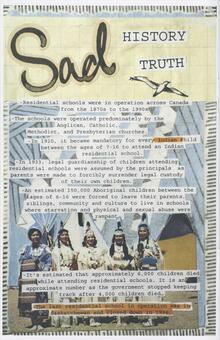
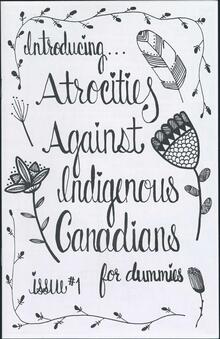
An active collecting area for Special Collections & Archives (SCA), we preserve archival and published material related to Indigenous Peoples in Ontario, Canada, Australia, and Norway.
SCA recently purchased a zine series by Nehiyaw/Anishinaabe/Lenape artist, Jenna Rose Sands. Shocked by the ignorance of non-Indigenous Canadians regarding Indigenous peoples and issues, Sands created the Canada Atrocities Against Indigenous Canadians for Dummies website and zine series. Created using a collage of original artwork, photography and text, the zines discuss residential schools, missing and murdered Indigenous women and girls, the 60s scoop, Pow Wow etiquette and cultural appropriation.
Sand's first issue in this series Atrocities Against Indigenous Canadians for Dummies issue 1, Residential Schools discusses this very difficult and tragic part of Canadian history as does another zine geared towards school-age children, What is a Residential School, an Introductory Mini Zine for Youth.
If you're interested in learning more about Jenna Rose or purchasing a copy of her zines, you can visit her website. For information on available Indigenous archives and published material in SCA, visit our Indigenous Peoples thematic area on the Archives Database. You can also use a keyword search in the Library's catalogue. Special Collections & Archives also has some items in Algonquin and Iroquoian Languages including Cree, Oneida, Ojibwe, and Seneca. We're always more than happy to hear from you. Please contact us with any questions or comments you may have.
Recommended reads
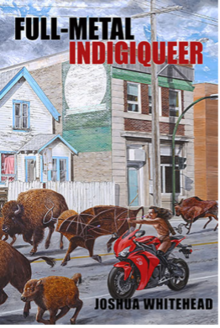 In Full-metal Indigiqueer by Joshua Whitehead: "This poetry collections focuses on a hybridized Indigiqueer Trickster character named Zoa who brings together the organic (the protozoan) and the technologic (the binaric) in order to re-beautify and re-member queer Indigeneity. This Trickster is a Two-Spirit/Indigiqueer invention that resurges in the apocalypse to haunt, atrophy, and to reclaim. Following oral tradition (à la Iktomi, Nanaboozho, Wovoka), Zoa infects, invades, and becomes a virus to canonical and popular works in order to re-centre Two-Spirit livelihoods." Request Full-Metal Indigiqueer from Omni, the Library's catalogue.
In Full-metal Indigiqueer by Joshua Whitehead: "This poetry collections focuses on a hybridized Indigiqueer Trickster character named Zoa who brings together the organic (the protozoan) and the technologic (the binaric) in order to re-beautify and re-member queer Indigeneity. This Trickster is a Two-Spirit/Indigiqueer invention that resurges in the apocalypse to haunt, atrophy, and to reclaim. Following oral tradition (à la Iktomi, Nanaboozho, Wovoka), Zoa infects, invades, and becomes a virus to canonical and popular works in order to re-centre Two-Spirit livelihoods." Request Full-Metal Indigiqueer from Omni, the Library's catalogue.
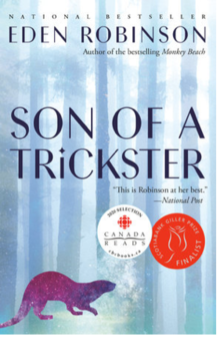 The first in a trilogy, Son of a Trickster by Eden Robinson: "Meet Jared Martin: sixteen-year-old pot cookie dealer, smoker, drinker and son with the scariest mom ever. But Jared's the pot dealer with a heart of gold — really. Compassionate, caring, and nurturing by nature, Jared's determined to help hold his family together — whether that means supporting his dad's new family with the proceeds from his baking or caring for his elderly neighbours. But when it comes to being cared and loved, Jared knows he can't rely on his family. His only source of love and support was his flatulent pit bull Baby, but she's dead. And then there's the talking ravens and the black outs and his grandmother's perpetual suspicion that he is not human, but the son of a trickster." Request Son of a Trickster from Omni, the Library's catalogue.
The first in a trilogy, Son of a Trickster by Eden Robinson: "Meet Jared Martin: sixteen-year-old pot cookie dealer, smoker, drinker and son with the scariest mom ever. But Jared's the pot dealer with a heart of gold — really. Compassionate, caring, and nurturing by nature, Jared's determined to help hold his family together — whether that means supporting his dad's new family with the proceeds from his baking or caring for his elderly neighbours. But when it comes to being cared and loved, Jared knows he can't rely on his family. His only source of love and support was his flatulent pit bull Baby, but she's dead. And then there's the talking ravens and the black outs and his grandmother's perpetual suspicion that he is not human, but the son of a trickster." Request Son of a Trickster from Omni, the Library's catalogue.
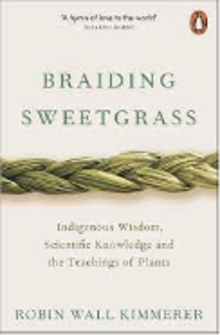 This non-fiction novel, Braiding Sweetgrass: Indigenous Wisdom, Scientific Knowledge and the Teachings of Plants by Robin Wall Kimmerer provokes deep thought on how our lives and language interact with the natural world. Delving into how Native Americans and their environment have been heavily impacted by colonization, Robin Wall Kimmerer examines who Native American wisdom can help us restore the natural environment, using the idea that plants and animals are our oldest teachers. As a member of the Citizen Potawatomi Nation, Robin Wall Kimmerer bring their perspectives to celebrate the relationship we have with the rest of the living world. Request Braiding Sweetgrass from Omni, the Library's catalogue.
This non-fiction novel, Braiding Sweetgrass: Indigenous Wisdom, Scientific Knowledge and the Teachings of Plants by Robin Wall Kimmerer provokes deep thought on how our lives and language interact with the natural world. Delving into how Native Americans and their environment have been heavily impacted by colonization, Robin Wall Kimmerer examines who Native American wisdom can help us restore the natural environment, using the idea that plants and animals are our oldest teachers. As a member of the Citizen Potawatomi Nation, Robin Wall Kimmerer bring their perspectives to celebrate the relationship we have with the rest of the living world. Request Braiding Sweetgrass from Omni, the Library's catalogue.
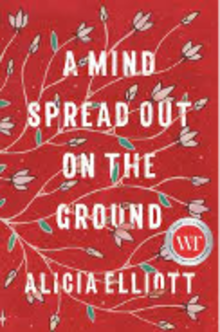 In this collection of essays, A Mind Spread out on the Ground by Alicia Elliot provokes thought on the treatment of Native people in North America. By answering important questions of how depression, colonialism, and loss of language are interconnected and how white privilege operates in different contexts Alicia Elliot delves into many pressing topics like race, love, mental illness, parenthood, poverty, sexual assault, gentrification, writing, and representation. Request A Mind Spread Out on the Ground from Omni, the Library's catalogue.
In this collection of essays, A Mind Spread out on the Ground by Alicia Elliot provokes thought on the treatment of Native people in North America. By answering important questions of how depression, colonialism, and loss of language are interconnected and how white privilege operates in different contexts Alicia Elliot delves into many pressing topics like race, love, mental illness, parenthood, poverty, sexual assault, gentrification, writing, and representation. Request A Mind Spread Out on the Ground from Omni, the Library's catalogue.
How to be an ally
How to be an ally to Indigenous Peoples at University of Waterloo — guidelines to show care and concern for people in our community:
- Stay mindful of the tremendous emotional impact that news and events have on Indigenous students, faculty and staff.
- Self-identify your perspective when approaching discussions.
- Be an ally to our Indigenous students, faculty and staff by giving them space (physical and digital) when they need it.
- Seek information from trusted sources to learn more about issues, opportunities and challenges faced by Indigenous communities in Canada.
Learn more on University of Waterloo's Indigenization Strategy website.
This informative toolkit created by the Montreal Urban Aboriginal Community Strategy Network breaks down what it means to be an Ally, accomplice and co-resistor, differentiating between the three terms and expanding on how one can better educate and equip themself to fight alongside not only Indigenous groups, but all marginalized groups. This kit provides steps that allies can follow as well as "Do's and Don'ts'' related to being an ally to Indigenous persons/groups. Additionally, it provides and defines certain terminology relevant to allyship and Indigenous culture and affairs.
Decolonizing together: Moving beyond a politics of solidarity toward a practice of decolonization
This article by Harsha Walia places emphasis on defining solidarity, and what Indigenous solidarity looks like. Furthermore, this article goes into detail on how to create and sustain allyship and alliances with Indigenous communities. The process of decolonization is also defined and explained within the context of relationships between Indigenous persons and allies.
Further concepts to keep in mind
- Look at history and educate yourself. It is not the job of BIPOC or 2SLGBTQIA+ individuals to inform or educate you.
- Be self-aware of your intentions.
- Be mindful of history and events that are impactful and/or sensitive.
- Use appropriate and relative language pertaining to Indigenous persons and groups.
- Get involved
- Look into local activism and pay attention to activist groups and news, such as Land Back Camp.
- Sign petitions relating to Indigenous rights and learn the history and current reality of issues Indigenous people are facing.
- Donate to reputable charities, including these seven Indigenous non-profits.
- Support Indigenous artists and businesses. Below is a short list of some Indigenous-owned and operated business in Canada:
- Birch Bark Coffee Co. was established in 2018, offering organic, Fair Trade coffee that is SPP certified and is grown and produced by farmers that are Indigenous descendants.
- Mitigomin Agriculture is a green enterprise that values the environment, health, tradition and nature. Located on Algonquin territory, they have a love for all plants but specialize in herbs and native species. They sell over 25 different varieties of herbal teas that are grown organically in their gardens.
- Cheekbone Beauty is an Indigenous-owned and founded, digitally-native, Canadian cosmetics company established in 2016. Based out of St. Catharines, Ontario, Cheekbone Beauty is known for creating high quality, cruelty-free beauty products such as liquid lipsticks and complexion products including contour and highlight palettes.
- Beam Paints is the result of a multi-generational love of pigment, paint, colour, and innovation. Owner Anong Beam was taught from a young age how to harvest hematite pigment in the LaCloche mountain range near our home in M'Chigeeng First Nation on Manitoulin Island. Beam Paints draws on their early educations in Indigenous pigment and expands it to encompass all paint traditions. A focus on high quality pigment content creates sublime artist materials, with plastic free packaging.
- Wabanaki Maple is 100% Indigenous female-owned and located on Neqotkuk (Tobique First Nation). Wabanaki Maple is proud to introduce you to this tradition that's shared by many Peoples of the Wabanaki Confederacy; Wolastoqiyik, Mi'kmaq, Penobscot, Abenaki, and Passamaquoddy. They are committed to helping to preserve our environment and helping Indigenous communities thrive.
Accomplices Not Allies: Abolishing the Ally Industrial Complex — an Indigenous Perspective
Don’t wait around for anyone to proclaim you to be an accomplice, you certainly cannot proclaim it yourself. You just are or you are not. The lines of oppression are already drawn. Direct action is really the best and may be the only way to learn what it is to be an accomplice. We’re in a fight, so be ready for confrontation and consequence.
This commentary by Indigenous Action Media can be a tough but crucial read for those that want to be involved in confronting colonialism. The writer rejects allyship, seeing the term as having been "rendered ineffective and meaningless" from commodification and exploitation.
Do it yourself!
Foraging
Indigenous knowledge of plants and foraging has a long history of connecting humans to the earth. It is important for us to understand the colonial practices that have impacted the connection Indigenous and non-Indigenous communities have with our food. Indigenous communities understand the importance of connecting with the food we eat on a deeper level, as food nourishes us physically and spiritually. There is a need to find balance between protecting Indigenous traditions and knowledge, and helping and educating others. Colonial practices have commoditized the food system, disconnecting us from the source of our foods. As Black Elk states in Decolonizing Foraging and Amplifying Indigenous Knowledge, "If non-Indigenous people can go around knowing plants are relatives, people are way less likely to exploit."
Moreover, the sustainability and safety of foraging are crucial to consider. When foraging, it is important to be 100% sure that what you're foraging it is safe to eat and will not cause harm. This means ensuring there aren’t toxins in nearby areas, including pollutants from busy roads or contaminated water sources. Further, the sustainability of foraging must be maintained by not over harvesting, leaving rare and protected plants as they are, and only collecting the parts of the plant that you will use. With the help of a mentor, online resources, and printed resources, we can all become expert foragers in no time. Learn more about foraging from the Northern Forest Foraging Guide. See below for some plants to keep an eye out for on your next walk or hike!
Cedar
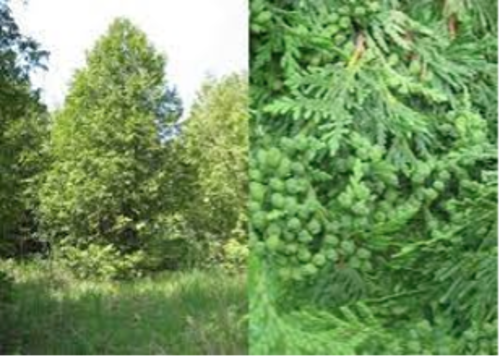
|
How to identify |
Uses |
Benefits |
Helpful tips |
Caution |
|---|---|---|---|---|
|
How to identify
|
Uses
|
Benefits
|
Helpful tips
|
Caution
|
Jack Pine

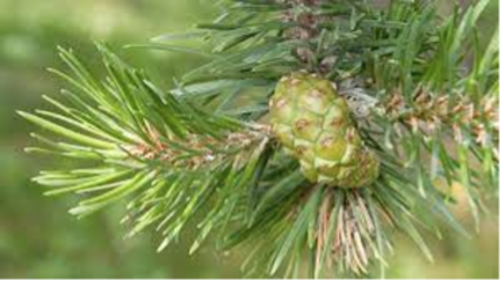
|
How to identify |
Uses |
Benefits |
Helpful tips |
Caution |
|---|---|---|---|---|
|
How to identify
|
Uses
|
Benefits
|
Helpful tips
|
Caution
|
Paper Birch bark
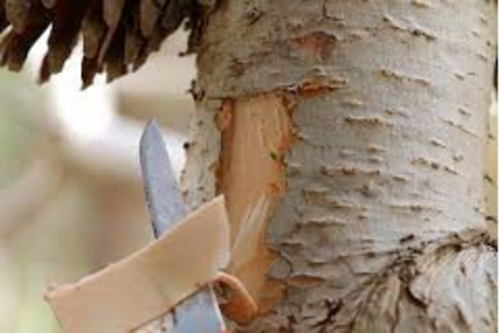
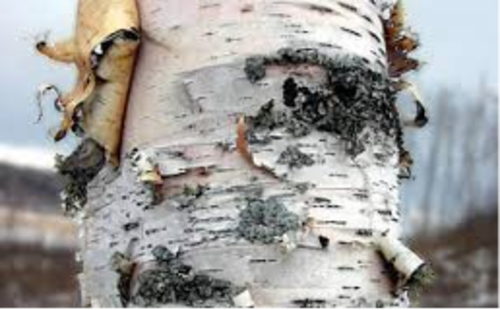
|
How to identify |
Uses |
Benefits |
Helpful tips |
Caution |
|---|---|---|---|---|
|
How to identify
|
Uses
|
Benefits
|
Helpful tips
|
Caution
|
Dandelion
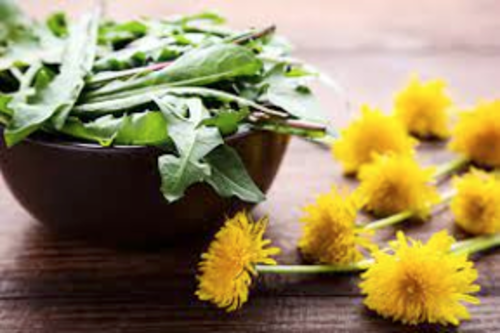
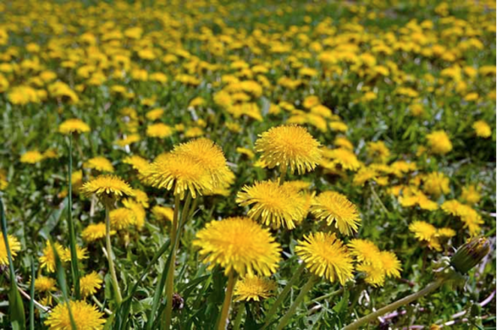
|
How to identify |
Uses |
Benefits |
Helpful tips |
Caution |
|---|---|---|---|---|
|
How to identify
|
Uses
|
Benefits
|
Helpful tips
|
Caution
|
Goldenrod
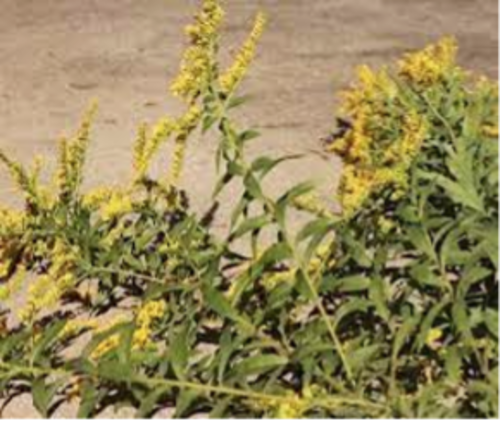
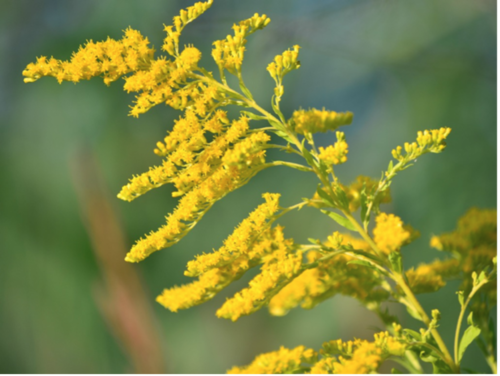
|
How to identify |
Uses |
Benefits |
Helpful tips |
Caution |
|---|---|---|---|---|
|
How to identify
|
Uses
|
Benefits
|
Helpful tips
|
Caution
|
Local Indigenous art
Indigenous artist: Alanah Jewell
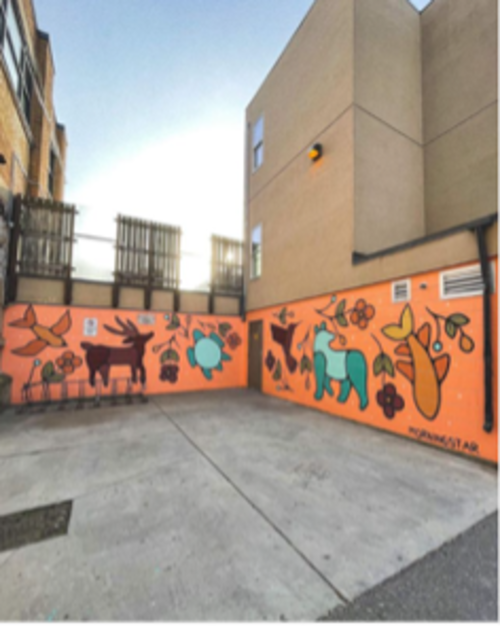
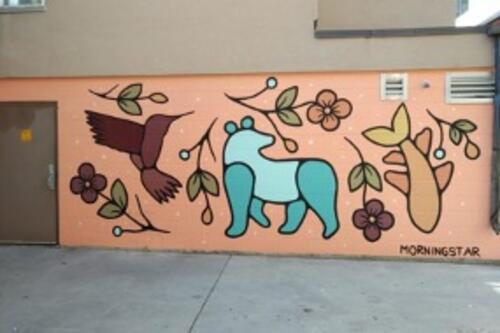
Kinship is a reflection of two different, parallel worlds: one where we long to be connected to community, and one where we are fully immersed in community.
Alanah Astehtsi Otsistohkwa (Morningstar) Jewell is Bear Clan from Oneida Nation of the Thames. A Wilfrid Laurier University Honours Sociology graduate, she's an Indigenous artist and photographer who uses digital illustrations, acrylic paintings on wood and canvas, and mural work to bring Indigenous art and representation to urban spaces. Alanah is also a community organizer and hosts Indigenous Art Markets in her home city of Kitchener, Ontario. Read more about Alanah from Explore Waterloo, CAFKA, Kitchener Today and The Community Edition, or visit her website, Morningstar Designs.
Celebrating its 20th anniversary in 2021, CAFKA is pleased to announce the CAFKA.21 biennial, Everything Not Saved Will Be Lost (PDF). "In line with ever evolving public health directives, the biennial will take place as a series of activations throughout the course of the summer, bringing contemporary art to primarily outdoor public spaces across Kitchener, Waterloo and Cambridge. CAFKA.21's theme, Everything Not Saved Will Be Lost, invites us to reflect on our everyday practices, our values, and our hopes. It also asks us to think about the things that could and perhaps should be left behind. Sixteen projects, including performance, sculpture, interactive media, and film will be featured." There are many Indigenous artists performing and showcasing their artworks, including Raven Davis and Shawn Johnston. Learn more on the CAFKA website.
Puzzles


Indigenous Peoples crossword clues
Across
1 Indigenous-led movement for self-determination of Indigenous peoples (two words).
3 Legally non-binding resolution dealing with protection of Indigenous peoples worldwide (abbreviation).
7 Knowledge or worldview held by Indigenous cultures about their environment, as well as the development and use of technologies for hunting, forestry, etc. (abbreviation).
10 Structure of governance where members are elected, not a pre-colonial way of governing but introduced by the federal government through the Indian Act (two words).
11 Indigenous people were finally granted this without losing any of their treaty rights and Indian status in 1960 (three words).
12 Canadian act of Parliament first passed in 1876 resulting in the creation of residential schools, the system of Indian reserves, etc.
14 Non-elected members of an Indigenous governance system that precedes British colonization (two words).
15 Term referring to specific groups of people generally living in the far north, means “the people”.
18 Name for the continent based on Indigenous creation story where a sea creature holds the land on its back.
19 Poet, artist, activist, and author of Talking to the Diaspora, a member of the Stó:lō Nation (two words).
20 Celebration in which the more gifts given, the higher the status achieved by the host based on the belief the most rich should give the most away , means "to give”.
Down
2 First word of Indigenous owned beauty brand with the low waste lipstick line called SUSTAIN.
4 Tract of land set aside under the Indian Act and treaty agreements for the exclusive use of an Indian band (First Nation).
5 Airs and produces programs made by, for and about Indigenous peoples in Canada (abbreviation).
6 Mohawk, Oneida, Onondaga, Cayuga, Seneca, and later the Tuscarora – these nations of the Iroquois Confederacy are also known as the (two words).
8 The term for loss of status rights, meant to encourage assimilation and become a British subject.
9 Used by Indigenous people to record treaties and significant events (two words).
13 Term used to describe Indigenous peoples of Canada who are ethnically neither Métis nor Inuit (two words).
16 Modification of the test used to define the rights of Aboriginal people (the Van der Peet test), used to define Métis rights (two words).
17 Term referring to a collective of cultures and ethnic identities that resulted from unions between Aboriginal and European people in what is now Canada.
Puzzle answers

Indigenous Peoples crossword answers
Across
1 Land Back
3 UNDRIP
7 TEK
10 Band council
11 Right to vote
12 Indian Act
14 Hereditary Chiefs
15 Inuit
18 Turtle Island
19 Lee Maracle
20 Potlatch
Down
2 Cheekbone
4 Reserve
5 APTN
6 Six Nations
8 Enfranchisement
9 Wampum Belt
13 First Nations
16 Powley Test
17 Metis

